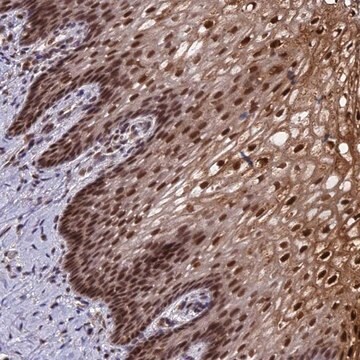MABE1057
Anti-ADA3 Antibody, clone 5C9/C8
clone 5C9/C8, from mouse
Synonyme(s) :
Transcriptional adapter 3, ADA3 homolog, ADA3-like protein, Alteration/deficiency in activation 3, hADA3, STAF54, Transcriptional adapter 3-like
About This Item
Produits recommandés
Source biologique
mouse
Niveau de qualité
Forme d'anticorps
purified immunoglobulin
Type de produit anticorps
primary antibodies
Clone
5C9/C8, monoclonal
Espèces réactives
human, mouse
Technique(s)
ChIP: suitable
immunocytochemistry: suitable
immunohistochemistry: suitable (paraffin)
western blot: suitable
Isotype
IgG1κ
Numéro d'accès NCBI
Numéro d'accès UniProt
Conditions d'expédition
ambient
Modification post-traductionnelle de la cible
unmodified
Informations sur le gène
human ... TADA3(10474)
Description générale
Spécificité
Immunogène
Application
Chromatin Immunoprecipitation (ChIP) Analysis: A representative lot detected ADA3 occupancy at the X chromosome centromere HOR region, the kinetochore assembly site also occupied by CENP-A and CENP-B, using TERT-immortalized human mammary epithelial cell 76N-TERT chromatin preparation. shRNA-mediated ADA3 knockdown led to a reduction in CENP-B, but not CENP-A, recruitment to the HOR region (Mohibi, S., et al. (2015). J. Biol. Chem. 290(47):28299-28310).
Immunocytochemistry Analysis: A representative lot detected ADA3 nuclear immunoreactivity in untransfected, but not ADA3 shRNA-transfected, TERT-immortalized human mammary epithelial 76N-TERT cells by fluorescent immunocytochemistry staining of 4% formaldehyde-fixed cells. Dual fluorescent staining revealed ADA3 and CENP-B nuclear colocalization (Mohibi, S., et al. (2015). J. Biol. Chem. 290(47):28299-28310).
Western Blotting Analysis: Representative lots detected both the endogenous mouse ADA3 (mADA3) and the exogenously expressed human ADA3 (hADA3) in Ada3FL/FL MEFs virally infected to express FLAG-tagged full-length or a.a. 111-432 hADA3 constructs. Cre recombinase expression downregulated only mADA3, but not hADA3 (Mohibi, S., et al. (2015). J. Biol. Chem. 290(47):28299-28310; Mohibi, S., et al. (2012). J. Biol. Chem. 287(35):29442-29456).
Western Blotting Analysis: A representative lot detected ADA3 expression levels among a panel of mouse tissues (Mohibi, S., et al. (2012). J. Biol. Chem. 287(35):29442-29456).
Epigenetics & Nuclear Function
Qualité
Western Blotting Analysis: A 1:1,000 dilution of this antibody detected ADA3 in 10 µg of MCF-7 cell lysate.
Description de la cible
Forme physique
Stockage et stabilité
Autres remarques
Clause de non-responsabilité
Vous ne trouvez pas le bon produit ?
Essayez notre Outil de sélection de produits.
Code de la classe de stockage
12 - Non Combustible Liquids
Classe de danger pour l'eau (WGK)
WGK 1
Point d'éclair (°F)
Not applicable
Point d'éclair (°C)
Not applicable
Certificats d'analyse (COA)
Recherchez un Certificats d'analyse (COA) en saisissant le numéro de lot du produit. Les numéros de lot figurent sur l'étiquette du produit après les mots "Lot" ou "Batch".
Déjà en possession de ce produit ?
Retrouvez la documentation relative aux produits que vous avez récemment achetés dans la Bibliothèque de documents.
Notre équipe de scientifiques dispose d'une expérience dans tous les secteurs de la recherche, notamment en sciences de la vie, science des matériaux, synthèse chimique, chromatographie, analyse et dans de nombreux autres domaines..
Contacter notre Service technique







